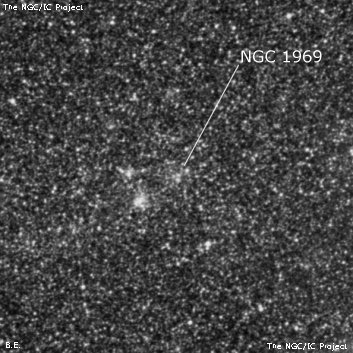
John Herschel discovered NGC 1969 = h2872 in Dec 1834 and recorded on NGC 1969 "the 4th of several running together (fig 7, Pl IV). F; S; attached to a larger (the 5th)." The 5th refers to NGC 1971 = h2875. His position is accurate. James Dunlop possibly discovered this cluster earlier on 24 Sep 1826 and noted (D 93) "a very faint nebula, about 30" diameter." His position is ~5' SE of the NGC 1969/1971/1972 trio, but visually NGC 1971 is the most prominent of the group. So, my guess is that D 93 refers to NGC 1971.
Joseph Turner sketched the field (along with NGC 1958, 1971 and 1972) on 21 Dec 1875 using the 48" Great Melbourne Telescope. See plate III, figure 29 at www.docdb.net/history/texts/1885osngmt________e/index.php#m_3_29
600/800mm - 24" (4/7/08 - Magellan Observatory, Australia): this is the first in a compact right triangle of clusters with NGC 1971 1.2' SE and NGC 1972 1.4' E (within stellar association LH 59). At 260x it appeared moderately bright, fairly small, round. This cluster has a lower surface brightness than NGC 1971 and 1972. A mag 13 star is at the NW edge. NGC 1958 lies 5' W. Located along the southeast side of the LMC bar, with a relatively bright background glow
Notes by Steve Gottlieb